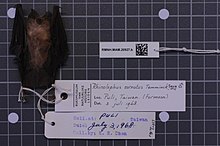
The Japanese house bat or Japanese pipistrelle is a species of vesper bat. An adult has a body length of 3.6–4.8 cm (1.4–1.9 in), a tail of 2.9–4.0 cm (1.1–1.6 in), and a wing length of 3.2–3.6 cm (1.3–1.4 in). It prefers to roost under the ceiling or inside the roof of old buildings. It is found across East Asia, from China and Taiwan into the Ussuri region, the Korean Peninsula, and Japan.

Ikonnikov's bat is a species of vesper bat. An adult Ikonnikov's bat has a body length of 4.2-5.1 cm, a tail of 3.1-4.0 cm, and a wing length of 3.3-3.6 cm. It is found in eastern Siberia, the Ussuri region, Sakhalin, Hokkaido and Honshu (Japan), and the Korean Peninsula.

The northern bat is the most abundant species of bat in northern Eurasia. It is found from England to Hokkaidō and south to northern India. It is closely related to the serotine bat.
Sturdee's pipistrelle, also known as the Bonin pipistrelle bat, is a bat that was thought to have lived in Japan before officially becoming extinct in 2000. In 2020 the IUCN changed its official status to "extinct".
The Southeast Asian long-fingered bat is a species of vesper bat in the family Miniopteridae. It is endemic to Japan and has been assessed as endangered by the IUCN.

The lesser great leaf-nosed bat or lesser roundleaf bat is a species of bat in the family Hipposideridae. It is found in Japan. Its natural habitat is temperate forests.

The Ryukyu flying fox or Ryukyu fruit bat is a species of megabat in the family Pteropodidae. It is found in Japan, Taiwan, and the Batanes and Babuyan Islands of the Philippines. Its natural habitats are subtropical or tropical dry forests and subtropical or tropical swamps. It is threatened by habitat loss and by hunting for food and the IUCN classify it as "Vulnerable".
Imaizumi's horseshoe bat is a species of bat in the family Rhinolophidae. It is endemic to Japan. Its natural habitat is temperate forests. While it was formerly considered endangered by the IUCN, it is now considered synonymous with the least horseshoe bat, which is evaluated as least concern.
The pygmy bamboo bat is a species of vesper bat in the family Vespertilionidae. It is found in Southwest China and was discovered in 2007. The species is around 4 cm long and weighs between 2.6 and 3.5 grams.

The eastern water bat or Sakhalin bat is a species of mouse-eared bat. It was for a long time considered to be a subspecies of Myotis daubentonii.
The Japanese noctule is a species of bat belonging to the family Vespertilionidae. It is endemic to Japan.
The Japanese long-eared bat is a species of vesper bat endemic to Japan, where it is found in Hokkaido, Honshu and Shikoku. It has distinctive, long ears, hence its Japanese name, the 'rabbit bat'. Formerly included as a subspecies of the European bat Plecotus auritus, genetic studies now indicate Plecotus sacrimontis is a separate species.
The Japanese short-tailed bat is a species of bat belonging to the family Vespertilionidae. It is endemic to Japan where it is found at the base of the northern Japanese Alps, the Chichibu Mountains and Oze National Park, mostly at altitudes higher than 700 m.
Hypsugo alaschanicus, the Alashanian pipistrelle, is a species of bat in the family Vespertilionidae. It is found in China, South Korea, Mongolia, Japan, and Russia.






